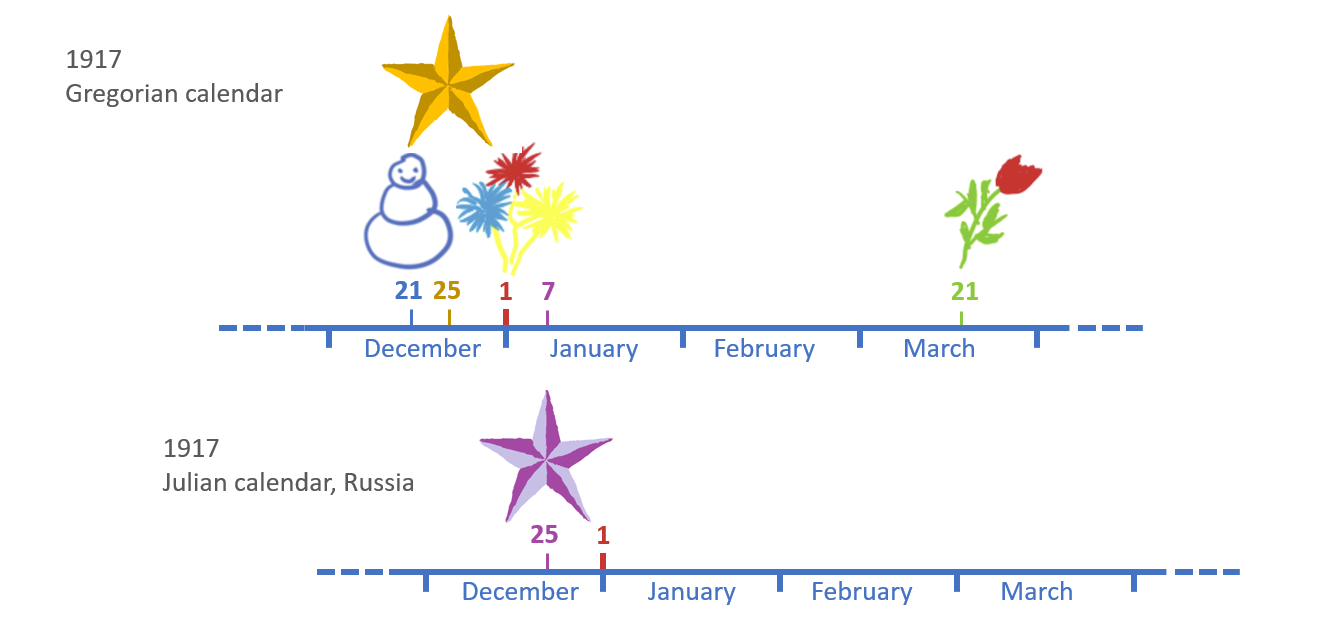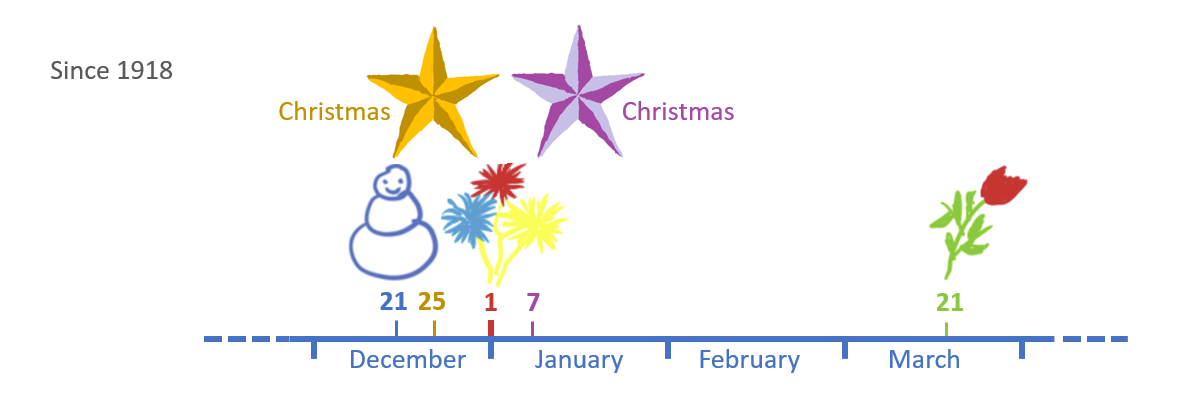Why are the Winter Solstice, Christmas and New Year not on the same Day?

Winter solstice, Christmas, New Year. All close together, but not on the same day. What’s more, Christmas is celebrated on different days in different parts of the world. Why is it all like this?
It all began in Rome
The origins of our calendar lie in Rome. In the Republican calender used in the centuries before Julius Caesar, the year began on March 1st. Unlike today, the Romans wanted their year to begin on the day of Spring equinox. This is the day on which day and night are the same length and (astronomical) spring begins in the northern hemisphere.

The Romans thought it made sense for a month to correspond to the time between one new moon and the next new moon. That is approximately 29.5 days. With twelve months, the Roman year therefore only had 355 days. The missing 10 days were simply compensated for every two years by a special month, which was inserted between February and March.
Let’s start in January
Scholars are somewhat divided as to when and why, but one thing is certain: At some point, the Romans decided to start the year in January rather than March. This had the somewhat illogical effect that the month of December, which means the tenth month in Latin, was then the twelfth month of the year. But what the heck. There were probably good political reasons, and in such situations logic has to take a back seat.

Times change, and unfortunately so does the beginning of the year
The first Roman calendars assumed that a year was exactly 365 days long. In reality, however, the earth takes about a quarter of a day longer to orbit the sun. If this is not taken into account, the spring equinox shifts further and further towards the end of the year. However, this shift did not seem to be so important to the Romans at first.
But then came Julius Caesar. Of course, someone like Caeser had to clean up the calendar thoroughly. He introduced the Julian calendar in 45 BC. He added a few days to a few months so that they had the number of days we know today. And he defined every fourth year as a leap year, which had an additional leap day. Because people were so used to it, this leap day was placed in February - even though February was no longer the last month of the year. This brings us to the calendar we know today. Only two month names have changed since then: Quintilis became Iulius (in honor of Julius Caesar) and Sextilis became Augustus (in honor of Emperor Augustus).
Julius Caesar reorganizes everything, the winter solstice gets a new date
The spring equinox in the old Roman calendar had shifted to May. That’s why Caesar had to insert a few special months and extra days to bring the spring equinox back into March. But on which day should the new year begin with the new calendar? Caesar could have made it so that the spring equinox was again on the first of March. But instead he decided that the new year should begin with the first new moon after the winter solstice.
The Winter solstice is the day on which the night is longest and the day is shortest in the northern hemisphere. Today we also regard this day as the (astronomical) beginning of Winter in the northern hemisphere.
It is not entirely clear why Caesar decided to start the new year on the first new moon after the winter solstice. Presumably because he was first and foremost a politician and adapted the calendar so that there was as little resistance as possible in his state. As a result, the winter solstice was on December 23 in the new calendar. But somehow in Caesar’s time, or a few years later, December 25 was considered the day of the winter solstice. The Kiwi Hellenist blog assumes that the Romans reckoned with the day that the Greek astronomer Callippus had researched around 330 BC as the day of the winter solstice.

Emperor Aurelian celebrates the sun, on the day of the winter solstice
From the winter solstice, the days become longer again. The sun gains power. Emperor Aurelian regarded the sun god as his personal protector and had a temple built for him, which was dedicated 274 AD on the winter solstice. From then on, December 25 was an important holiday - perhaps the Romans also regarded it as the birthday of the sun god.

It’s Christmas time
Christianity became increasingly influential in the following decades and sometime in the fourth century, December 25 was no longer celebrated as the birthday of the sun god, but as the birthday of Jesus. Since then, Christmas has been on December 25.
So Christmas took place on the (imaginary) day of the winter solstice for quite some time.

Times change, and unfortunately so does the day of the winter solstice
The Julian calendar introduced by Caesar worked well for several centuries. But it was not perfect. The Julian calendar calculates with a year length of 365.25 days. In reality, however, the year is about 11 minutes shorter. Therefore, the Julian calendar goes forward by one day after approx. 130 years. Throughout the Middle Ages, this doesn’t seem to have really bothered anyone. It was not until 1582, under Pope Gregory XIII, that things began to move again.
The first correction in the new Gregorian calendar was to reduce the number of leap years: A year that is divisible by 100 but not by 400 was deleted as a leap year. This ensured that the calendar year had the correct length in the long term.
But due to the errors of the Julian calendar, the winter solstice had meanwhile changed to December 11 in 1581, and the spring equinox had shifted to March 11:

Pope Gregory lets spring begin on March 21
Easter is a very important day for the Catholic Church. Easter is on a different calendar day every year because the church sets the Date of Easter depending on spring exquinox. That’s why the church didn’t like the fact that spring equinox had moved up to March 11. So a major change was necessary.
Which day should the church choose? Quite simply, the church went back to the year 325. In this year, the Council of Nicaea had taken place, in which the calculation of the date of Easter had been determined. In 325, the spring equinox was on March 21. And this should be the case again in the new Gregorian calendar for the year 1582.
Because spring equinox was on March 11 in the Julian calendar, ten days had to be omitted for the gregorian calendar in 1582 in order to get the spring equinox on March 21. Christmas was left unchanged on December 25. Because the spring equinox is on March 21, the winter solstice is on December 21

Happy New Year
Soon all the winter calendar days will be here. The only thing missing is New Year.
When should people celebrate the start of the new year? On the day of the winter solstice, at Christmas, on the first of January? With this confusion in the calendar, it’s not so easy to decide. In the end, however, most countries have sooner or later settled on the first of January. That’s why New Year’s Day is now a public holiday in many countries.

Christmas on January 7
We can make it a little more complicated. In Russia and other Eastern European countries, Christmas is not celebrated on December 25, but on January 7.
This is because at the time of the Gregorian calendar reform, the Orthodox Church ruled in Russia and not the Catholic Church. The Orthodox Church had no interest in switching from the Julian calendar to the Catholic Gregorian calendar. Russia switched to the Gregorian calendar much later, in 1918. In the years between 1582 and 1918, however, the calendars were three days further apart and shifted by thirteen days. December 25 in the Julian calendar was on January 7 in the Gregorian calendar:

To align the calendars, thirteen days were omitted in 1918. As a result, Christmas in Soviet Russia was postponed to January 7. And that’s where it stayed in Russia and other Eastern European countries to this day.

But wait, this year the winter solstice is on December 22nd and not December 21st
To make it a little easier to describe, I have referred to the winter solstice on December 21. In reality, however, the winter solstice takes place every few years on December 22. If you look in this table, you can see that this can happen before a leap year. As explained above, this is because the 365 days of our calendar are slightly shorter than the real astronomical year. This is corrected in the leap year, and the winter solstice is brought back to December 21. For similar reasons, the winter solstice sometimes even takes place on December 20 (next in 2080) or December 23 (next in 2303).
Summary
Today’s calendar is the result of more than 2000 years of European history. Ancient Greeks and Romans, the Catholic and Orthodox churches, and Soviet Russia, they all had their share. It will be interesting to see what happens next.
Comment on this post ❤️
I am very interested in what readers think of this post and what ideas or questions they have. The easiest way to do this is to respond to my anonymous survey.